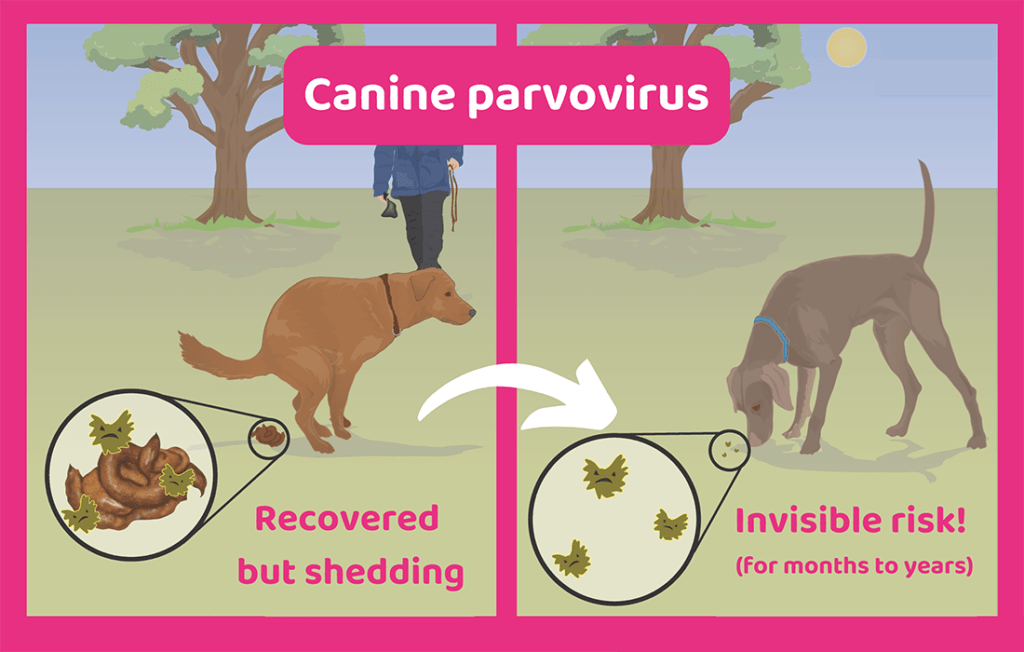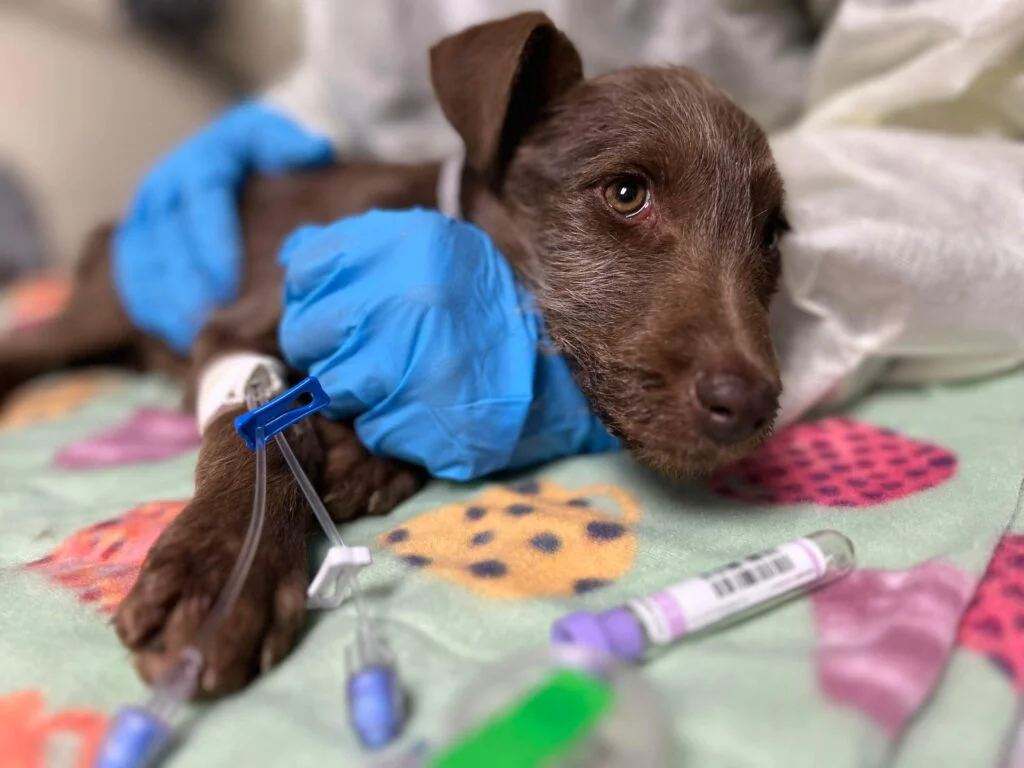Überblick

Was ist Parvovirus?
Parvovirus (auch bekannt als Parvo, Canines Parvovirus oder CPV) ist ein Virus, das bei Hunden schwere Erkrankungen und den Tod verursacht. Es schädigt die Darmschleimhaut und verursacht schweres Erbrechen und Durchfall. Es greift auch infektionsbekämpfende Zellen im Knochenmark an, was das Immunsystem schwächt und es Hunden sehr schwer macht, sich zu erholen. Besonders schwerwiegend ist das Parvovirus bei ungeimpften Hunden und Welpen unter sechs Monaten, da deren Immunsystem nicht so gut entwickelt ist und sie daher weniger in der Lage sind, das Virus zu bekämpfen.

Wie bekommen Hunde Parvo?
Die meisten Hunde infizieren sich beim Erkunden mit dem Parvovirus. Es wird drei bis vier Tage nach der Infektion mit dem Kot infizierter Hunde ausgeschieden und dann noch einige Wochen lang, nachdem die Symptome abgeklungen sind. Leider kann er dann Monate bis Jahre in der Umwelt überleben – was bedeutet, dass er fast überall zu finden ist, wo sich Hunde aufhalten, beispielsweise in Gärten, Parks und auf Feldern. Es kann auch im Schmutz wandern und so auf der Unterseite von Schuhen, in Häusern, an Hundeleinen, Halsbändern, Schüsseln, Kleidung, Spielzeug und sogar auf menschlichen Händen gefunden werden.
Die meisten Hunde sind irgendwann in ihrem Leben dem Parvovirus ausgesetzt, daher ist die einzige Möglichkeit, sie zu schützen, eine regelmäßige Impfung.

Symptome von Parvo bei Hunden?
Die Symptome des Parvovirus treten normalerweise nach drei bis sieben Tagen auf und umfassen:
Parvovirus bei Hunden diagnostizieren?
Ein Parvo-Test ist nicht immer notwendig, da die Symptome normalerweise sehr offensichtlich sind. Bei Bedarf kann die Diagnose jedoch mit einem schnellen Kottest gestellt werden, der in etwa 15 Minuten ein Ergebnis liefert. Dieser Test ist normalerweise sehr genau, aber wenn das Ergebnis nicht Ihren Erwartungen entspricht, kann er es überprüfen, indem er etwas Kot in ein Labor schickt.
Ihr Tierarzt führt möglicherweise auch Blutuntersuchungen durch, um den Gehalt an infektionsbekämpfenden Zellen zu überprüfen und um festzustellen, ob eine Anämie durch Blutverlust vorliegt.
Welche Behandlungsmöglichkeiten gibt es?
Da es keine Heilung gibt, benötigen Hunde mit Parvovirus eine sehr intensive Pflege und Medikamente zur Kontrolle ihrer Symptome, während ihr Körper versucht, die Infektion zu bekämpfen. Die Behandlung umfasst normalerweise:
Sie kümmern sich um einen Hund, der sich vom Parvovirus erholt?
Wenn sich Ihr Hund so weit erholt hat, dass er nach Hause zurückkehren kann, müssen Sie ihn weiter pflegen, während er sich vollständig erholt:
Wird mein Hund Parvo überleben?
Die Chance, dass Ihr Hund das Parvovirus überlebt, ist viel höher, wenn Sie ihn zum Tierarzt bringen, sobald Sie Symptome bemerken. Bei Hunden, die während ihres Krankenhausaufenthalts in einer Tierarztpraxis umgehend intensivmedizinisch versorgt werden, ist die Überlebenschance deutlich höher, aber aufgrund der Schwere des Parvovirus sterben einige Hunde trotz der Behandlung leider. Parvovirus verläuft ohne Behandlung fast immer tödlich. Bei Welpen besteht ein höheres Sterberisiko, insbesondere bei Welpen, die jünger als zwei Wochen sind.
Wann sollten Sie Ihren Tierarzt kontaktieren?
Wenden Sie sich sofort an Ihren Tierarzt, wenn Ihr Hund Parvovirus-Symptome zeigt. Lassen Sie sie wissen, dass Sie denken, dass es sich um Parvo handeln könnte, und warten Sie vor der Klinik, bis Ihr Hund gerufen wird, um zu verhindern, dass es auf andere Hunde im Wartezimmer übertragen wird.
Es besteht keine Notwendigkeit, Ihren Tierarzt zu kontaktieren, wenn Ihr Hund einfach mit dem Parvovirus in Kontakt gekommen ist. Beobachten Sie ihn einfach genau auf Symptome und rufen Sie Ihren Tierarzt um Rat, wenn Sie besorgt sind.
Parvovirus verhindern?
Impfungen – Die beste und einzige Möglichkeit, einer Parvovirus-Infektion vorzubeugen, ist die regelmäßige Impfung Ihres Hundes. Als Welpe benötigen sie zwei bis drei Parvovirus-Impfstoffe und für den Rest ihres Lebens regelmäßig Auffrischungsimpfungen.
Kaufen/umbauen Sie verantwortungsvoll – Kaufen Sie immer bei einem verantwortungsvollen Züchter oder einem seriösen Vermittlungszentrum. Stellen Sie sicher, dass Sie Ihren Welpen und seine Geschwister mehr als einmal mit ihrer Mutter an dem Ort sehen, an dem sie aufgezogen werden. Alle Welpen sollten gesund und munter sein und keine Anzeichen einer Krankheit aufweisen, und ihre Mutter sollte über ihre Impfungen auf dem Laufenden sein.
Einen neuen Welpen rausbringen – Bei ungeimpften Welpen und Welpen, die erst die erste Impfung erhalten haben, besteht das Risiko, sich mit dem Parvovirus anzustecken. Ein bis zwei Wochen nach Abschluss der ersten Impfung kann Ihr Welpe sicher spazieren gehen und andere Hunde treffen. Befolgen Sie daher bis dahin die folgenden Ratschläge:
Wie hoch sind die Kosten für die Behandlung des Parvovirus?
Die Behandlung des Parvovirus kann Hunderte, wenn nicht Tausende von Dirham kosten, da die meisten Hunde mehrere Tage intensiver Behandlung in einer Tierklinik benötigen. Es ist wichtig, mit Ihrem Tierarzt offen über Ihre Finanzen, die Behandlungskosten und darüber zu sprechen, was Ihrer Meinung nach für Ihren Hund das Richtige ist.
Wie lange sollte ich warten, bis ich einen Welpen bekomme, nachdem ich einen Hund durch Parvovirus verloren habe?
Wenn Sie kürzlich einen Hund durch Parvovirus verloren haben, wird das Virus noch lange in Ihrem Haus und Garten überleben. Es kann Monate bis Jahre in der Umwelt verbleiben und es ist fast unmöglich sicherzustellen, dass Sie es vollständig entfernen, insbesondere in Bereichen, die schwer zu desinfizieren sind, wie zum Beispiel im Garten. Das bedeutet, dass alle ungeimpften Hunde/Welpen, die zu Ihnen nach Hause kommen, dem Risiko ausgesetzt sind, sich mit dem Parvovirus anzustecken.
Wenn Sie erwägen, sich einen neuen Welpen anzuschaffen, empfehlen wir Ihnen, mit der Heimkehr zu warten, bis er vollständig geimpft ist (Sie müssen sicherstellen, dass er vom Züchter/Rettungszentrum ordnungsgemäß sozialisiert wird). Wenn dies keine Option ist, können Sie das Risiko, dass sie sich mit dem Parvovirus infizieren, verringern, indem Sie Ihr Zuhause gründlich desinfizieren und sie von Ihrem Garten fernhalten, bis sie vollständig geimpft sind. Sprechen Sie für weitere Ratschläge mit Ihrem Tierarzt und lesen Sie weiter unten, wie Sie Parvoviren desinfizieren können.
Wie desinfiziert man nach Parvovirus?
Es ist wichtig, alle mit Parvoviren kontaminierten Bereiche vollständig zu desinfizieren.
Bleichmittel können bei richtiger Anwendung Parvoviren abtöten. Es ist leicht verfügbar und relativ kostengünstig, weist jedoch einige Nachteile auf. Es kann Oberflächen verfärben oder sogar ruinieren. Die Dämpfe können Nase, Augen und Haut reizen.
Um das Hunde-Parvovirus auf harten, nicht porösen Oberflächen abzutöten, bereiten Sie eine Lösung aus Bleichmittel und Wasser vor. Waschen Sie die Bereiche vor und wischen oder wischen Sie sie anschließend mit der Desinfektionslösung ab. Zehn Minuten einwirken lassen, dann gründlich ausspülen und an der Luft trocknen. Eine Behandlung sollte das Virus abtöten, solange Sie die richtige Verdünnung verwenden und eine Kontaktzeit von zehn Minuten einhalten. In diesem Fall würden wir auch eine neu gekaufte Flasche Bleichmittel verwenden, um sicherzustellen, dass der Bleichmittelwirkstoff die auf dem Etikett angegebene Stärke aufweist. Verwenden Sie keine Flasche Bleichmittel, die zu lange herumstand, da das Bleichmittel mit der Zeit auf natürliche Weise in Salz und Wasser zerfällt.
Erhalten Sie Antworten auf häufig gestellte Fragen zu Parvoviren.

| Plätzchen | Dauer | Beschreibung |
|---|---|---|
| cookielawinfo-checkbox-analytics | 11 Monate | This cookie is set by GDPR Cookie Consent plugin. The cookie is used to store the user consent for the cookies in the category "Analytics". |
| cookielawinfo-checkbox-funktional | 11 Monate | The cookie is set by GDPR cookie consent to record the user consent for the cookies in the category "Functional". |
| cookielawinfo-checkbox-notwendig | 11 Monate | This cookie is set by GDPR Cookie Consent plugin. The cookies is used to store the user consent for the cookies in the category "Necessary". |
| cookielawinfo-checkbox-others | 11 Monate | This cookie is set by GDPR Cookie Consent plugin. The cookie is used to store the user consent for the cookies in the category "Other. |
| cookielawinfo-checkbox-performance | 11 Monate | This cookie is set by GDPR Cookie Consent plugin. The cookie is used to store the user consent for the cookies in the category "Performance". |
| angesehene_cookie_policy | 11 Monate | Das Cookie wird vom DSGVO-Plugin „Cookie Consent“ gesetzt und dient dazu, zu speichern, ob der Benutzer der Verwendung von Cookies zugestimmt hat oder nicht. Es werden keine personenbezogenen Daten gespeichert. |
Erstellen Sie ein Konto oder melden Sie sich an, um Haustiere zu speichern, die Sie lieben.
Sie haben noch kein Konto? Kontaktieren Sie uns
Bevor Sie mit Ihrem Adoptionsantrag fortfahren, lesen und akzeptieren Sie bitte unsere Datenverarbeitungspraktiken:
Notiz: By clicking "I Agree & Continue", you will be redirected to an external application form. This tracking system logs your interest but does not capture data from the external form.